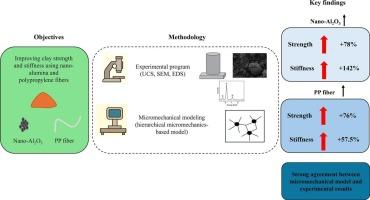Micromechanical study of clay stabilized with nano-Al2O3 particles and reinforced by polypropylene short micro-fibers
IF 7.9
2区 材料科学
Q1 MATERIALS SCIENCE, MULTIDISCIPLINARY
引用次数: 0
Abstract
Understanding the geomechanical behavior of clayey soils is essential in geotechnical engineering. This study investigates the combined effects of nano-Al2O3 particles and polypropylene (PP) short micro-fibers on clay through laboratory testing and micromechanical modeling. A hierarchical micromechanics-based model is proposed to predict the effective stiffness of nano-Al2O3/PP/clay ternary composites, explicitly incorporating microstructural parameters such as filler content, geometry, and interfacial bonding. The model accounts for the PP–clay interfacial region, nanoparticle dispersion, fiber waviness, and orientation. Clay samples were stabilized with 0–1 % nano-Al2O3 and 0–1.2 % PP fibers by dry weight, and unconfined compression tests were conducted to determine unconfined compressive strength (UCS) and stiffness (E50). At 1.2 % PP fiber content, increasing nano-Al2O3 improved UCS by up to 78 % and E50 by up to 142 %. Likewise, PP fibers enhanced UCS by 76 % and E50 by 57.5 %. SEM analysis revealed nanoparticle-induced particle interlocking and fiber-enhanced cohesion, while EDS confirmed the integration of Al and C elements into the soil matrix. Experimental results showed strong agreement with model predictions, validating the proposed approach. This micromechanical framework provides an effective predictive tool for optimizing fiber- and nano-modified clays, contributing to more efficient and sustainable soil stabilization practices.

纳米氧化铝稳定聚丙烯短纤维增强粘土的微观力学研究
了解粘性土的地质力学特性在岩土工程中是必不可少的。本研究通过室内试验和微观力学模型研究了纳米al2o3颗粒和聚丙烯(PP)短微纤维对粘土的联合作用。提出了一种基于分层细观力学的模型来预测纳米al2o3 /PP/粘土三元复合材料的有效刚度,该模型明确地结合了填料含量、几何形状和界面键合等微观结构参数。该模型考虑了pp -粘土界面区域、纳米颗粒分散、纤维波纹度和取向。用0 - 1%纳米al2o3和0 - 1.2% PP纤维(按干重计)稳定粘土样品,进行无侧限压缩试验,测定无侧限抗压强度(UCS)和刚度(E50)。当PP纤维含量为1.2%时,增加纳米al2o3可使UCS提高78%,E50提高142%。同样,PP纤维可使UCS提高76%,E50提高57.5%。SEM分析显示纳米颗粒诱导的颗粒联锁和纤维增强的凝聚力,EDS分析证实Al和C元素整合到土壤基质中。实验结果与模型预测结果一致,验证了该方法的有效性。这种微力学框架为优化纤维和纳米改性粘土提供了有效的预测工具,有助于更有效和可持续的土壤稳定实践。
本文章由计算机程序翻译,如有差异,请以英文原文为准。
求助全文
约1分钟内获得全文
求助全文
来源期刊

Materials & Design
Engineering-Mechanical Engineering
CiteScore
14.30
自引率
7.10%
发文量
1028
审稿时长
85 days
期刊介绍:
Materials and Design is a multi-disciplinary journal that publishes original research reports, review articles, and express communications. The journal focuses on studying the structure and properties of inorganic and organic materials, advancements in synthesis, processing, characterization, and testing, the design of materials and engineering systems, and their applications in technology. It aims to bring together various aspects of materials science, engineering, physics, and chemistry.
The journal explores themes ranging from materials to design and aims to reveal the connections between natural and artificial materials, as well as experiment and modeling. Manuscripts submitted to Materials and Design should contain elements of discovery and surprise, as they often contribute new insights into the architecture and function of matter.
 求助内容:
求助内容: 应助结果提醒方式:
应助结果提醒方式:


